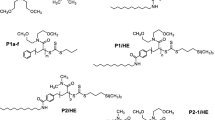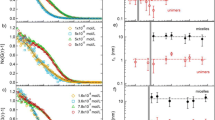Abstract
The effect of poly N-isopropylacrylamide (PNIPAM) blocks on the thermoresponsive behavior of multiblock copolymers with polyacrylamide (PAM) backbones synthesized via RAFT polymerization in aqueous solution is examined. These multiblock copolymers (or multistickers) were prepared by the sequential polymerization of acrylamide and N-isopropylacrylamide. Initially, a hydrophilic macro-RAFT PAM is synthesized using acrylamide (AM), [S, S′-bis(α,α′-dimethyl-α″-acetic acid)-trithiocarbonate (DMAT)] as a chain transfer agent, and 4,4′-azobis(4-cyanopentanoic acid) (ACPA) as an initiator. Chain extensions were carried out by the sequential polymerization of N-isopropylacrylamide (NIPAM) or acrylamide (PAM). Multiblock copolymers (tri-, penta-, hepta- and nonablock) were acquired by the insertion of 1, 2, 3 or 4 NIPAM blocks, respectively. The resultant copolymers were characterized by nuclear magnetic resonance (NMR) spectroscopy, size-exclusion chromatography (SEC), dynamic light scattering (DLS), ultraviolet-visible (UV-vis) spectroscopy and rheometry. Rheological analyses were performed at different temperatures from 25 to 70 °C, and the data showed an increase in the apparent viscosity of the copolymers from the macro-chain transfer agent to the nonablock copolymer. The lower critical solution temperature (LCST) was measured for each polymer, and the resulting values were found fluctuate as a function of the number of thermoresponsive blocks incorporated into the thermoresponsive copolymers.









Similar content being viewed by others
References
Shalaby SW, McCormick CL, Butler GB (1991) Water-soluble polymers: synthesis, solution properties, and applications. American Chemical Society, Washington, DC
Wever DAZ, Picchioni F, Broekhuis AA (2011) Polymer for enhanced oil recovery: a paradigm for structure-property relationship in aqueous solution. Prog Polym Sci 11:1558
Jiménez-Regalado E, Selb J, Candau F (2000) Phase behavior and rheological properties of aqueous solutions containing mixtures of associating polymers. Macromolecules 33:8720–8730
Volpert E, Selb J, Candau F (1996) Influence of the hydrophobe structure on composition, microstructure, and rheology in associating polyacrylamides prepared by micellar copolymerization. Macromolecules 29:1452–1463
Hill A, Candau F, Selb J (1993) Properties of hydrophobically associating polyacrylamides: influence of the method of synthesis. Macromolecules 26:4521–4532
McCormick CL, Nonaka T, Johnson CB (1988) Water-soluble copolymers: 27. Synthesis and aqueous solution behaviour of associative acrylamide N-alkylacrylamide copolymers. Polymer 29:731–739
Tam KC, Jenkins RD, Winnik MA, Bassett DR (1998) A structural model of hydrophobically modified urethane−ethoxylate (HEUR) associative polymers in shear flows. Macromolecules 31:4149–4159
Jiménez-Regalado E, Selb J, Candau F (1999) Viscoelastic behavior of semidilute solutions of multisticker polymer chains. Macromolecules 32:8580–8588
Maechling-Strasser C, Clouet F, François J (1992) Hydrophobically end-capped polyethylene-oxide urethanes: 2. Modelling their association in water. Polymer 33:1021–1025
Maechling-Strasser C, François J, Clouet F, Tripette C (1992) Hydrophobically end-capped poly (ethylene-oxide) urethanes: 1. Characterization and experimental study of their association in aqueous solution. Polymer 33:627–636
Yekta A, Duhamel J, Brochard P, Adiwidjaja H, Winnik MA (1993) A fluorescent probe study of micelle-like cluster formation in aqueous solutions of hydrophobically modified poly (ethylene oxide). Macromolecules 26:1829–1836
Ezzell SA, Hoyle CE, Creed D, McCormick CL (1992) Water-soluble copolymers. 40. Photophysical studies of the solution behavior of associative pyrenesulfonamide-labeled polyacrylamides. Macromolecules 25:1887–1895
Branham KD, Shafer GS, Hoyle CE, McCormick CL (1995) Water-soluble copolymers. 61. Microstructural investigation of pyrenesulfonamide-labeled polyelectrolytes. Variation of label proximity utilizing micellar polymerization. Macromolecules 28:6175–6182
Ezzell SA, McCormick CL (1992) Water-soluble copolymers. 39. Synthesis and solution properties of associative acrylamido copolymers with pyrenesulfonamide fluorescence labels. Macromolecules 25:1881–1886
Velazquez-García A, Rivera-Vallejo C, Cadenas-Pliego G, Pérez-Alvarez M, Díaz de León-Gómez R, Jiménez-Regalado E (2015) Synthesis, characterization and rheological properties of telechelic polyelectrolytes. Rev Téc Ing Univ Zulia 38:69–79
Jimenez-Regalado E, Cadenas-Pliego G, Pérez-Álvarez M, Hernández-Valdez Y (2004) Characterization and rheological properties of dilute-solutions of three different families of water-soluble copolymers prepared by solution polymerization Macromol. Research 12:451–458
Jimenez-Regalado E, Cadenas-Pliego G, Pérez-Álvarez M, Hernández-Valdez Y (2004) Study of three different families of water-soluble copolymers: synthesis, characterization and viscoelastic behavior of semi-dilute solutions of polymers prepared by solution polymerization. Polymer 45:1993–2000
Roy D, Cambre JN, Sumerlin BS (2010) Future perspectives and recent advances in stimuli-responsive materials. Prog Polym Sci 35:278–301
Gil ES, Hudson S, Pizarro A, David R (2004) Stimuli-reponsive polymers and their bioconjugates. Prog Polym Sci 29:1173–1222
Hua F, Jiang X, Li D, Zhao B (2006) Well-defined thermosensitive, water-soluble polyacrylates and polystyrenics with short pendant oligo (ethylene glycol) groups synthesized by nitroxide-mediated radical polymerization. Polym Sci A Polym Chem 44:2454–2467
Tirrell DA (1987) Macromolecular switches for bilayer membranes. J Control Release 6:15–21
Kitano H, Akatsuka Y, Ise N (1991) pH-responsive liposomes which contain amphiphiles prepared by using lipophilic radical initiator. Macromolecules 2:42–46
Bales BL, Messina L, Vidal A, Peric M (1998) Precision relative aggregation number determinations of SDS micelles using a spin probe. A model of micelle surface hydration. J Phys Chem B 102:10347–10358
Li Y, Xue L, Xia H, Xu B, Wen S, Tian W (2008) Synthesis and properties of polythiophene derivatives containing triphenylamine moiety and their photovoltaic applications. J Polym Sci A Polym Chem 46:3970–3984
Costas R, Freitas R (2002) Phase behavior of poly (N-isopropylacrylamide) in binary aqueous solutions. Polymer 43:5879–5885
Hourdet D, L’Alloret F, Audebert R (1994) Reversible thermothickening of aqueous polymer solutions. Polymer 35:2624–2630
Durand A, Hourdet D (2000) Thermoassociative graft polymers based on poly (N-isopropylacrylamide): effect of added co-solutes on the rheological behaviour. Polymer 41:545–557
Jenkins AD, Jones RG, Moad G (2009) Terminology for reversible-deactivation radical polymerization previously called “controlled” radical or “living” radical polymerization (IUPAC recommendations 2010). Pure Appl Chem 82:483–491
Hawker CJ (1994) Molecular weight control by a “living” free-radical polymerization process. J Am Chem Soc 116:11185–11186
Tebben L, Studer A (2011) Nitroxides: applications in synthesis and in polymer chemistry. Angew Chem Int Ed 50:5034–5068
Lessard B, Marić M (2008) Nitroxide-mediated synthesis of poly (poly (ethylene glycol) acrylate) (PPEGA) comb-like homopolymers and block copolymers. Macromolecules 41:7870–7880
Payne KA, Nesvadba P, Debling J, Cuninngham MF, Hutchinson RA (2015) Nitroxide-mediated polymerization at elevated temperatures. ACS Macro Lett 4:280–283
Burguiere C, Chassenieux C, Charleux B (2003) Characterization of aqueous micellar solutions of amphyphylic block copolymers of poly (acrylic acid) and polystyrene prepared via ATRP. Toward the control of the number of particles in emulsion polymerization. Polymer 44:509–518
Matyjaszewski K (2012) Atom transfer radical polymerization (ATRP): current status and future perspectives. Macromolecules 45:4015–4039
Burdyńska J, Cho HY, Mueller L, Matyjaszewski K (2010) Synthesis of star polymers using ARGET ATRP. Macromolecules 43:9227–9229
Moad G, Chong K, Postma A, Rizardo E, Thang SH (2005) Advances in RAFT polymerization: the synthesis of polymers with defined end-groups. Polymer 46:8458–8468
Lowe AB, McCormick CL (2007) Reversible addition–fragmentation chain transfer (RAFT) radical polymerization and the synthesis of water-soluble (co) polymers under homogeneous conditions in organic and aqueous media. Prog Polym Sci 32:283–351
Zhang W, D’Agosto F, Dugas P, Rieger J, Charleux B (2013) RAFT-mediated one-pot aqueous emulsion polymerization of methyl methacrylate in presence of poly (methacrylic acid-co-poly (ethylene oxide) methacrylate) trithiocarbonate macromolecular chain transfer agent. Polymer 54:2011–2019
Derry MJ, Fielding LA, Armes SP (2016) Polymerization-induced self-assembly of block copolymer nanoparticles via RAFT non-aqueous dispersion polymerization. Prog Polym Sci 52:1–18
Moad G, Rizzardo E, Thang SH (2008) Toward living radical polymerization. Acc Chem Res 41:1133–1142
Martin L, Gody G, Perrier S (2015) Preparation of complex multiblock copolymers via aqueous RAFT polymerization at room temperature. Polym Chem 6:4875–4886
Wever DAZ, Raffa P, Picchioni F, Broekhuis AA (2012) Acrylamide homopolymers and acrylamide-N-isopropylacrylamide block copolymers by atomic transfer radical polymerization in water. Macromolecules 45:4040–4045
Wever DAZ, Polgar LM, Stuart MCA, Picchioni F, Broekhuis AA (2013) Polymer molecular architecture as a tool for controlling the rheological properties of aqueous polyacrylamide solutions for enhanced oil recovery. Ind Eng Chem Res 52:16993–17005
Raffa P, Broekhuis AA, Picchioni F (2016) Polymeric surfactants for enhanced oil recovery: a review. J Pet Sci Eng 145:723–733
Filippov SK, Bogomolova A, Kaberov L, Velychkivska N, Starovoytova L, Cernochova Z, Rogers SE, Lau WM, Khutoryanskiy VV, Cook MT (2016) Internal nanoparticle structure of temperature-responsive self-assembled PNIPAM-b-PEG-b-PNIPAM triblock copolymers in aqueous solutions: NMR, SANS, and light scattering studies. Langmuir 32:5314–5323
Cook MT, Filippov SK, Khutoryanskiy VV (2017) Synthesis and solution properties of a temperature-responsive PNIPAM–b-PDMS–b-PNIPAM triblock copolymer. Colloid Polym Sci 295:1351–1358
Lai JT, Filla D, Shea R (2002) Functional polymers from novel carboxyl-terminated trithiocarbonates as highly efficient RAFT agents. Macromolecules 35:6754–6756
Kolicker WM, Kniewske R (1982) Preparation, characterization solution properties and rheological behaviour of polyacrylamide. Prog Polym Sci 8:373–468
Gody G, Zetterlund PB, Perrier S, Harrisson S (2016) The limits of precision monomer placement in chain growth polymerization. Nat Commun 7:10514
Convertine AJ, Lokitz BS, Lowe AB, Scales CW, Myrick LJ, McCormick CL (2005) Aqueous RAFT polymerization of acrylamide and N,N-dimethylacrylamide at room temperature. Macromol Rapid Commun 26:791–795
Abel BA, McCormick CL (2016) Mechanistic insights into temperature-dependent trithiocarbonate chain-end degradation during the RAFT polymerization of N-arylmethacrylamides. Macromolecules 49:465–474
Díaz-Silvestre SE, St Thomas C, Rivera-Vallejo C, Cadenas-Pliego G, Pérez-Alvarez M, Díaz de León-Gómez R, Jiménez-Regalado EJ (2017) Concentration effect of N-isopropylacrylamide on viscoelastic properties of hydrosoluble thermo-thickening copolymers. Polym Bull 74:4009–4021
Okano T, Yamada N, Okuhara M, Sakai H, Sakurai Y (1995) Mechanism of cell detachment from temperature-modulated, hydrophilic-hydrophobic polymer surfaces. Biomaterials 16:297–303
Feil H, Bae YH, Feijen J, Kim SW (1993) Effect of comonomer hydrophilicity and ionization on the lower critical solution temperature of N-isopropylacrylamide copolymers. Macromolecules 26:2496–2500
Siriwatwechakul W, Teraphongphom N, Ngaotheppitak V, Kunataned S (2008) Thermo-sensitive hydrogel: control of hydrophilic-hydrophobic transition. Int J Chem, Molecular, Nuclear, Materials & Metall Eng 2:347–352
Spĕvácĕk J (2009) NMR investigations of phase transition in aqueous polymer solutions and gels. Curr Opin Colloid Interface Sci 14:184–191
Spĕvácĕk J, Konefal R, Dybal J, Čadiva E, Kovářová J (2017) Thermoresponsive behavior of block copolymers of PEO and PNIPAm with different architecture in aqueous solutions: a study by NMR, FTIR, DSC and quantum-chemical calculations. Eur Polym J 94:471–483
Hanyková L, Spĕvácĕk J, Marek Radecki M, Zhigunov A, Julie Štastná J, Valentová H, Sedláková Z (2015) Structures and interactions in collapsed hydrogels of thermoresponsive interpenetrating polymer networks. Colloid Polym Sci 293:709–720
Aseyev V, Hietala S, Laukkanen A, Nuopponen M, Confortini O, Du Prez FE, Tenhu H (2005) Mesoglobules of thermoresponsive polymers in dilute aqueous solutions above the LCST. Polymer 46:7118–7131
Virtanen J, Baron C, Tenhu H (2000) Grafting of poly (nisopropylacrylamide) with poly (ethylene oxide) under various reaction conditions. Macromolecules 33:336–341
Pospisilova A, Filippov SF, Bogomolova A, Turner S, Sedlacek O, Matushkin N, Cernochova Z, Stepanek P, Hruby M (2014) Glycogen-graft-poly(2-alkyl-2-oxazolines)-the new versatile biopolymer-based thermoresponsive macromolecular toolbox. RSC Adv 4:61580–61588
Zhang Q, Weber C, Schubert US, Hoogenboom R (2017) Thermoresponsive polymers with lower critical solution temperature: from fundamental aspects and measuring techniques to recommended turbidimetry conditions. Mater Horiz 4:109–116
Lara-Ceniceros TE, Cadenas-Pliego G, Rivera-Vallejo C, Díaz de León-Gómez R, Coronado A, Jiménez-Regalado E (2014) Synthesis and characterization of thermo-insensitive, water-soluble associative polymers with good thickening properties at low and high temperatures. J Polym Res 21:511
Acknowledgements
The authors would like to acknowledge the Consejo Nacional de Ciencia y Tecnología of México (CONACYT) for the financial support of this work through project numbers 255052 and 267962. The authors also thank Ricardo Mendoza-Carrizales, Judith Nazareth Cabello-Romero and J. Guadalupe Telles-Padilla for their help in the experimental characterization.
Author information
Authors and Affiliations
Corresponding authors
Ethics declarations
Conflict of interest
The authors declare that they have no competing interests.
Electronic supplementary material
ESM 1
(DOCX 1124 kb)
Rights and permissions
About this article
Cite this article
Díaz-Silvestre, S.E., St Thomas, C., Maldonado-Textle, H. et al. Effect of N-isopropylacrylamide thermoresponsive blocks on the rheological properties of water-soluble thermoassociative copolymers synthesized via RAFT polymerization. Colloid Polym Sci 296, 1699–1710 (2018). https://doi.org/10.1007/s00396-018-4391-y
Received:
Accepted:
Published:
Issue Date:
DOI: https://doi.org/10.1007/s00396-018-4391-y




